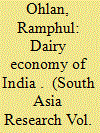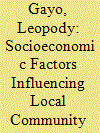|
|
|
Sort Order |
|
|
|
Items / Page
|
|
|
|
|
|
|
| Srl | Item |
| 1 |
ID:
146878


|
|
|
|
|
| Summary/Abstract |
India remains the world’s largest producer and consumer of milk. The present study empirically evaluates the transformations in demand and supply of dairy products in India, identifying that the share of dairy products in the food basket has significantly increased among both rural and urban consumers. While demand for dairy products is highly elastic and related to income, the analysis also shows large regional disparities in production and per capita availability of milk in India. After examining various aspects of dairy consumption and production patterns in India, the article also includes policy considerations to improve dairy production. It suggests that to stimulate dairy sector development and reduce inequality in dairy products consumption in India, milk and milk products should be included in the diet provided through the Midday Meal Schemes for primary education children. Overall, to meet the growing demand for dairy products, given their role in food security, the Government of India should continue to aim for sustained growth.
|
|
|
|
|
|
|
|
|
|
|
|
|
|
|
|
| 2 |
ID:
126938


|
|
|
| 3 |
ID:
088355


|
|
|
|
|
| Publication |
2009.
|
| Summary/Abstract |
This article examines the characteristics of the victims of the October 1993 massacres in Burundi. Using information on parents of the respondents of a 2002 demographic household survey, the author finds that the probability of a parent being killed during the events is significantly affected by age, sex and wealth, in the sense that older, wealthier and male persons were more likely to be killed. Using the median level of education of a parent's offspring to proxy the parental investment in human capital, the author finds that people who invested more in the human capital of their children ran a higher risk of being killed. The analysis also shows important spatial disparities in the killings. In trying to explain these locational effects, the author focus on two key hypotheses set forth with respect to the October 1993 events in Burundi: the land crisis and the questionable role played by the Front Démocratique du Burundi (FRODEBU), the dominant political actor at that time. The author finds that communal land pressure significantly increases the probability of being killed and that communal popular support for FRODEBU increases, in a non-linear fashion, the risk of being affected by the killings. The results are interpreted in light of the prevailing political economy of 1993 Burundi.
|
|
|
|
|
|
|
|
|
|
|
|
|
|
|
|
| 4 |
ID:
179104


|
|
|
|
|
| Summary/Abstract |
We assessed the factors influencing local community perceptions towards lions in the Selous Game Reserve, Tanzania. Data were collected from 384 households through questionnaire surveys, interviews, and focus group discussions, and analyzed by content analysis and IBM SPSS version 20. About 86% (n=331) of respondents had negative perceptions towards lions. Education (p=0.0016, R=1.68), occupation (p=0.0021, R=−2.07), livestock numbers (p=0.0011, R=0.-0.43), livestock management (p=0.0006, R=0.373), water sources (p=0.0019, R=−0.21), and distance from the protected area (p=0.0183, R=2.11) were significant factors for community perceptions towards lions. We recommend compensation for the victims of lion attacks to reduce negative attitudes towards the species
|
|
|
|
|
|
|
|
|
|
|
|
|
|
|
|
|
|
|
|
|